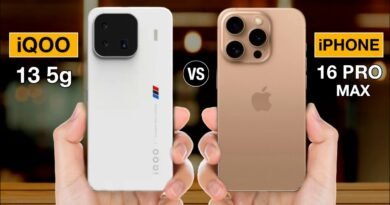Don’t Buy a Smart TV Without Checking These 7 Crucial Specs First
Purchasing a new smart TV can be exciting, but with the vast array of features and technologies on the market, choosing the right one can feel overwhelming. With so many brands, sizes, and specs to consider, it’s easy to get lost in the technical jargon. To make an informed decision and ensure you get the best value for your money, it’s essential to focus on the most important specifications.
This guide will explore the seven most important specs to check before buying a smart TV, helping you confidently choose the one that best suits your needs.
1. Screen Size and Dimensions

The first and most apparent consideration when buying a smart TV is the screen size. Bigger is often considered better, but size should be chosen based on the room where the TV will be placed and how far away viewers will sit. Here’s a breakdown of what you should consider:
Viewing Distance
The optimal TV screen size depends on how far you will sit from the screen. For a more immersive viewing experience, a good rule of thumb is that the TV should be at least one-third the distance between the TV and where you’ll sit. For example, if you are sitting 9 feet (108 inches) from the screen, a 55-65 inch TV would be ideal. This ensures that you can comfortably view the details without straining your eyes or constantly shifting your gaze across the screen.
Room Size
Beyond viewing distance, consider the physical dimensions of the room. A TV that is too large for a small space may dominate the room, making it feel cramped. Conversely, a TV that is too small in a large room may look out of place. Be sure to measure the space where you intend to place the TV, ensuring it will fit comfortably and that you’ll have enough room for other furniture and décor.
Popular Sizes
Modern smart TVs come in a wide range of sizes, from 32 inches to 85+ inches. However, the most popular sizes are in the 50-65 inch range, offering a great balance between screen size and affordability. For smaller rooms, a 40-50 inch TV might be ideal, while larger spaces can comfortably accommodate 65-inch or larger screens.
2. Resolution

Resolution refers to the number of pixels that make up the image on the screen, with higher resolutions offering more detailed and crisper images. In today’s market, you’ll find four primary resolutions: HD (720p), Full HD (1080p), 4K (2160p), and 8K (4320p).
4K (Ultra HD)
Currently, 4K resolution is the standard for most new smart TVs, offering four times the pixel count of Full HD. With a resolution of 3840 x 2160 pixels, 4K TVs provide stunning detail and clarity, especially noticeable on larger screens. As more streaming services and Blu-rays offer 4K content, this resolution ensures you’re future-proofing your TV purchase.
8K
For those seeking the cutting edge of TV technology, 8K TVs offer even higher resolution, with 7680 x 4320 pixels. While this offers an incredibly detailed image, 8K content is still relatively rare. If you’re a tech enthusiast or plan to use your TV for many years, an 8K TV might be a good investment, but for most people, 4K will suffice.
HDR and Content
When considering resolution, it’s also important to think about the content you’ll be watching. Many streaming platforms, such as Netflix and Amazon Prime, are expanding their 4K libraries, so you’ll have plenty of options to make the most of your high-resolution TV. However, if most of your viewing is cable or standard streaming, a 4K TV may not always showcase its full potential.
3. Screen Type (LED, OLED, QLED)

There are several different screen technologies to choose from, each offering distinct benefits in terms of picture quality, brightness, and color reproduction. The most common types are LED, OLED, and QLED.
LED
LED (Light Emitting Diode) TVs are the most widely available and affordable option. They use a backlight to illuminate pixels, which results in a bright picture, even in well-lit rooms. However, since LED TVs can’t turn off individual pixels, they may struggle to produce true black colors, especially in darker scenes.
OLED
OLED (Organic Light Emitting Diode) TVs are known for their incredible picture quality. Unlike LED TVs, OLEDs can turn off individual pixels completely, resulting in perfect blacks and stunning contrast. This makes them an excellent choice for movie lovers and those who want the best possible image quality. OLED screens are also thinner and more energy-efficient, but they tend to be more expensive than LED models.
QLED
QLED (Quantum Dot Light Emitting Diode) technology, popularized by Samsung, improves upon traditional LED technology by adding a quantum dot layer that enhances brightness and color accuracy. QLEDs excel in well-lit environments and are generally brighter than OLEDs, making them a good option for rooms with lots of natural light. However, they may not match OLEDs’ contrast and deep blacks in darker environments.
Verdict
If you’re seeking the best picture quality and don’t mind paying a premium, an OLED TV is the top choice. For those who watch TV in bright rooms or are looking for a more affordable option, QLED and LED TVs are still excellent choices.
4. HDR Compatibility

High Dynamic Range (HDR) is a crucial feature to look for in a modern smart TV. It enhances contrast and color accuracy, delivering more vivid and lifelike images. With HDR, you’ll notice brighter highlights, deeper blacks, and a broader range of colors.
HDR Formats
There are several different HDR formats available, with the most common being HDR10, Dolby Vision, and HDR10+.
- HDR10 is the most basic and widely supported format, offering improved brightness and color over non-HDR content.
- Dolby Vision is a more advanced format that supports dynamic metadata, allowing it to adjust settings scene by scene for optimal picture quality. It’s supported by platforms like Netflix and Disney+.
- HDR10+, similar to Dolby Vision, also supports dynamic metadata but is less widely adopted. Samsung TVs are the primary supporters of this format.
When choosing a TV, it’s important to ensure that it supports at least one of these HDR formats. Dolby Vision and HDR10+ offer the best experience, but HDR10 will still provide a noticeable improvement over standard dynamic range content.
Is HDR Worth It?
If you plan to watch movies, TV shows, or play games that support HDR, it’s worth choosing a TV with HDR capability. With more content creators adopting HDR, this feature is essential for future-proofing your TV.
5. Connectivity

When buying a smart TV, you’ll want to ensure it has all the necessary ports and connectivity options to suit your needs. Here are some of the most important connectivity features to consider:
HDMI Ports
HDMI (High Definition Multimedia Interface) ports are the most important connection points on any TV. You’ll need these ports to connect gaming consoles, Blu-ray players, streaming devices, and soundbars. Make sure your TV has enough HDMI ports to accommodate all your devices. A good minimum is three HDMI ports, though four or more is ideal if you have multiple devices.
HDMI 2.1
If you’re into gaming or want to future-proof your TV, look for HDMI 2.1 ports. This version supports higher resolutions (up to 8K) and faster refresh rates, making it perfect for next-gen gaming consoles like the PlayStation 5 and Xbox Series X.
USB Ports
USB ports are another useful feature, allowing you to connect external drives or charge devices. While not as critical as HDMI, having one or two USB ports is a nice bonus.
Ethernet and Wi-Fi
For streaming content and using smart features, you’ll need a reliable internet connection. Most smart TVs come with built-in Wi-Fi, but having an Ethernet port can provide a more stable connection, especially if you plan on streaming 4K content or playing online games.
Bluetooth
Bluetooth connectivity is a handy feature for wirelessly connecting peripherals like headphones, soundbars, or game controllers. This is particularly useful if you want to listen to TV late at night without disturbing others.
6. Refresh Rate
The refresh rate of a TV refers to how many times per second the image is refreshed on the screen, measured in hertz (Hz). Common refresh rates are 60Hz, 120Hz, and sometimes even higher.
Why Refresh Rate Matters
A higher refresh rate results in smoother motion, particularly noticeable during fast-paced action scenes or when watching sports. A 60Hz TV refreshes the image 60 times per second, which is fine for most general viewing. However, if you’re a gamer or watch a lot of fast-moving content, you might benefit from a 120Hz TV, which offers significantly smoother motion with less motion blur.
Motion Smoothing
Be aware that some TVs include motion-smoothing features that artificially increase the refresh rate, often leading to the “soap opera effect,” where everything looks overly smooth and unnatural. This feature can typically be turned off in the settings.
For Gamers
If you’re a gamer, particularly with next-gen consoles like the PlayStation 5 or Xbox Series X, a TV with a 120Hz refresh rate and support for Variable Refresh Rate (VRR) is highly recommended for the best gaming experience. This reduces screen tearing and provides a more responsive experience.
7. Operating System
A smart TV’s operating system (OS) determines the user experience and what streaming services or apps are available. Popular smart TV operating systems include Roku TV, Google TV, webOS (used by LG), and Tizen (used by Samsung). Each OS offers a different interface, app selection, and performance.
- Roku TV and Google TV are known for their wide app support and intuitive interfaces.
- webOS and Tizen are smooth and feature-rich, especially if you’re in the LG or Samsung ecosystems.
Ensure the OS supports your preferred apps and is easy to navigate for an optimal user experience.




